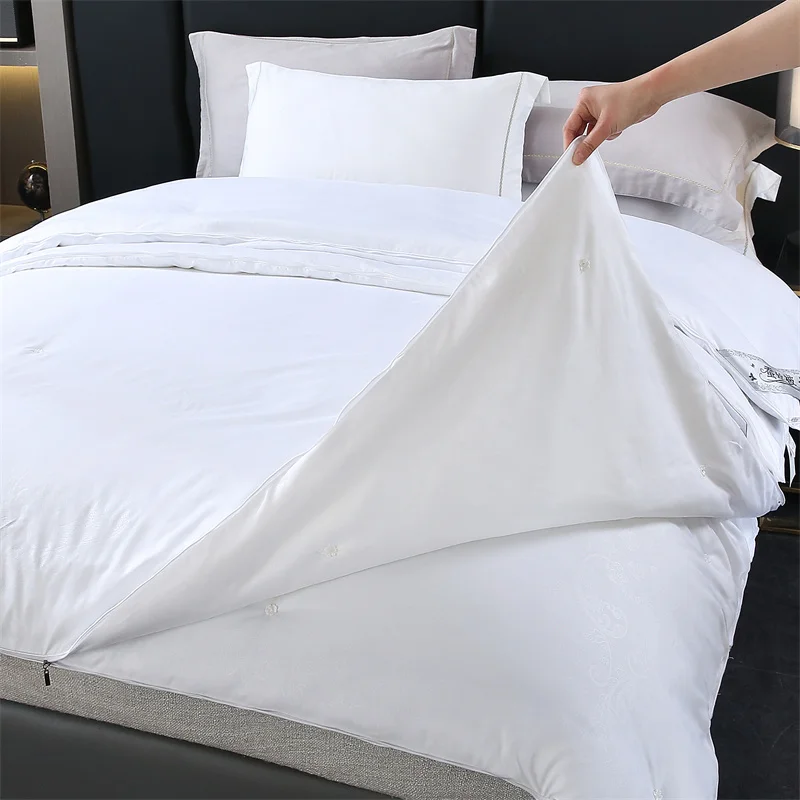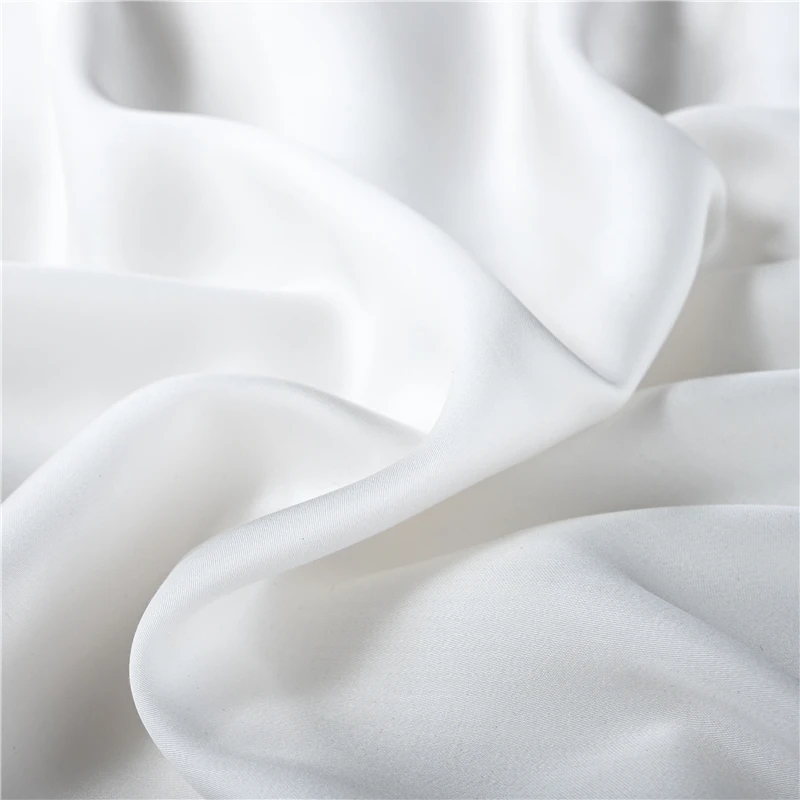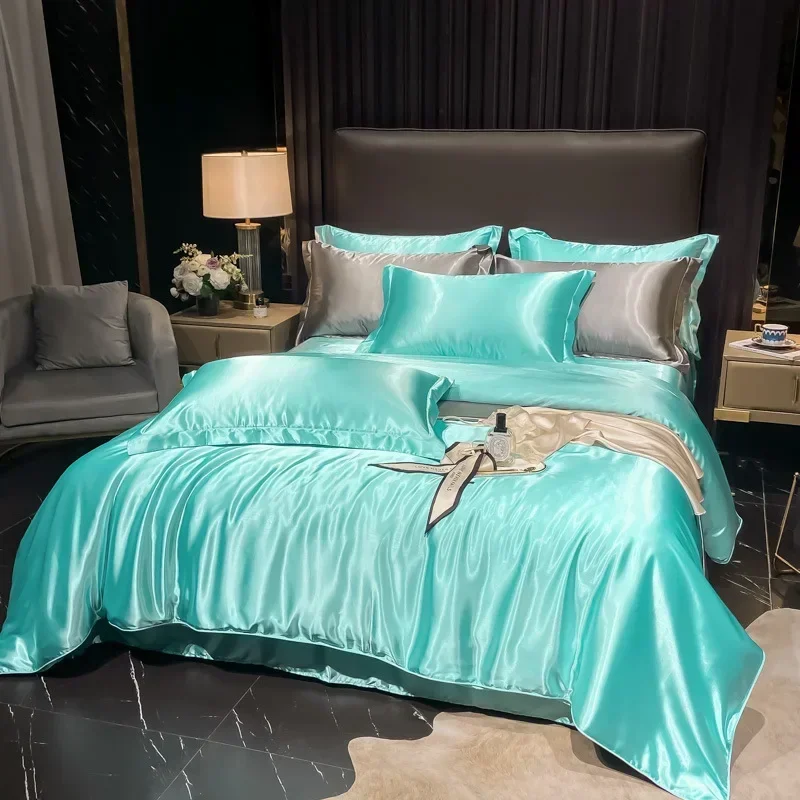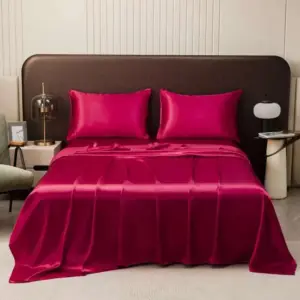The Unique Microstructure of Silk: Nature’s Perfect Temperature Regulator
Silk stands as one of nature’s most remarkable materials, a natural protein fiber produced by the Bombyx mori silkworm as it creates its cocoon. What makes silk exceptional for bedding isn’t just its luxurious feel, but its extraordinary molecular structure that naturally regulates temperature.
At its core, silk consists of two proteins: fibroin and sericin. Fibroin forms the structural backbone with its unique amino acid chains, creating a material unlike any other natural fiber. The molecular arrangement of silk creates a material that’s:
- Composed of triangular prism-like microstructures that allow for light refraction and air circulation
- Structured with microscopic air pockets that trap or release heat as needed
- Built from protein chains that respond differently to environmental conditions
This unique microstructure gives silk exceptional temperature regulation properties that synthetic materials simply cannot replicate. The hollow core of silk fibers creates natural insulation while simultaneously allowing for breathability—a paradoxical combination that makes silk uniquely suited for maintaining comfort during sleep.
When compared to other natural fibers like cotton or wool, silk’s molecular arrangement stands apart. Cotton fibers are flat and ribbon-like, while wool fibers have scales. Silk’s triangular prism structure creates more effective air pockets for thermal properties that adapt to the body’s needs throughout the night.
The finest bedding comes from mulberry silk sheets where silkworms feed exclusively on mulberry leaves, producing longer, more uniform fibers. This results in a stronger material with enhanced temperature-regulating capabilities—setting the foundation for the remarkable thermal performance we’ll explore throughout this article.
Exceptional Breathability: How Silk’s Structure Creates Perfect Airflow
One of silk’s most valuable properties is its exceptional breathability, which directly impacts how it regulates body temperature during sleep. Unlike tightly woven synthetic fabrics that trap air and heat, silk’s natural structure promotes continuous airflow around the body throughout the night.
The secret lies in silk’s unique fiber configuration and typical weaving patterns. When silk fibers are woven into fabric, they create a material that’s 10-15% more breathable than cotton despite maintaining a tight, smooth surface. This seemingly contradictory quality comes from silk’s natural spacing between fibers, which creates microscopic ventilation channels.
These ventilation channels allow air to circulate freely between your body and the bedding, creating what sleep experts call a “microclimate”—a stable temperature zone that helps maintain the ideal sleeping temperature of 60-67°F (15.5-19.4°C). This circulation prevents the buildup of heat that often leads to discomfort and disrupted sleep.
The temperature control capabilities of silk sheets are particularly valuable because they work automatically. When your body heats up, the natural airflow through the fabric helps dissipate excess warmth. This continuous ventilation process happens without conscious effort, helping maintain comfortable body temperature throughout the various stages of sleep.
This breathability factor becomes especially important during REM sleep, when the body’s temperature regulation system is less active. The constant air circulation created by silk’s structure helps compensate for the body’s reduced ability to self-regulate during these critical sleep phases.
Superior Moisture Management: The Science of Silk’s Wicking Properties
Beyond breathability, silk’s exceptional moisture management plays a crucial role in regulating body temperature during sleep. This natural fiber possesses remarkable wicking properties that actively move moisture away from the skin’s surface, creating a dry, comfortable sleep environment.
The process works through several key mechanisms:
- Silk fibers can absorb up to 30% of their weight in moisture without feeling wet to the touch
- The protein structure of silk pulls moisture away from the body through capillary action
- Once absorbed, moisture spreads along the fiber and evaporates more quickly than in other fabrics
- This evaporation process creates a natural cooling effect against the skin
What makes silk truly exceptional is how it handles this moisture compared to other fabrics. Cotton, while absorbent (about 25% of its weight), tends to hold moisture against the skin, creating that damp, clingy feeling that disrupts sleep. Silk, by contrast, wicks moisture 1.5-2x faster than many cotton weaves and dries approximately 40% faster.
This rapid moisture management process creates a cooling effect through evaporation. As your body releases heat and moisture during sleep, silk draws that moisture away and facilitates its evaporation, which naturally cools the body. This makes silk particularly effective at preventing night sweats and maintaining comfortable body temperature.
For those who tend to sleep hot or experience temperature fluctuations at night, cooling silk sheets specifically designed to maximize these moisture-wicking properties can make a significant difference in sleep quality. The continuous moisture management process works throughout the night, helping maintain optimal body temperature regardless of external conditions.
Natural Thermoregulation: How Silk Creates Perfect Thermal Balance
At the heart of silk’s temperature-regulating magic is its remarkable thermoregulation capacity—the ability to maintain balanced thermal conditions regardless of external temperatures. This capability stems from silk’s unusually low thermal conductivity among natural fibers.
Thermal conductivity refers to how readily a material transfers heat. Materials with high conductivity quickly transfer heat (like metal), while those with low conductivity (like silk) resist heat transfer. This resistance allows silk to create a stable temperature zone around your body during sleep.
What makes silk exceptional is how it combines this low conductivity with adaptive properties. The protein structure of silk fibers contains microscopic pockets that trap air, similar to how down insulation works but without the bulkiness. These air pockets respond dynamically to both your body temperature and the ambient room temperature.
When temperatures drop, these air pockets trap body heat close to the skin, providing gentle, lightweight warmth. When temperatures rise, silk’s breathable structure allows excess heat to dissipate rather than build up. This results in a remarkably stable microclimate that remains within 1-2°F (0.5-1°C) of optimal sleeping temperature throughout the night.
Many people wonder if silk truly regulates temperature or if it’s just marketing hype. The scientific evidence confirms that silk’s thermal properties aren’t just theoretical—they’re based on measurable physical characteristics that create real-world benefits for sleepers. The natural protein structure of silk fibers provides a level of thermal balance that synthetic materials simply cannot replicate.
This adaptive temperature response becomes particularly valuable during seasonal transitions or in homes with fluctuating temperatures, where maintaining consistent sleep comfort becomes challenging with other bedding materials.
Summer Comfort: How Silk Keeps You Cool When Temperatures Rise
When summer heat arrives, silk bedding reveals one of its most valuable qualities: exceptional cooling capabilities. The combination of silk’s breathability and moisture-wicking properties creates a sleeping environment that can significantly improve comfort during warm weather.

During hot weather, silk sheets provide several key cooling benefits:
- The smooth fiber surface prevents heat from being trapped against the skin
- Rapid moisture evaporation creates a natural cooling effect
- The breathable structure allows continuous air circulation even in humid conditions
- The temperature-regulating range works most effectively between 68-86°F (20-30°C)
Studies have shown that silk bedding can help reduce perceived temperature by 3-5°F (1.7-2.8°C) in warm conditions—a significant difference when trying to sleep comfortably on hot nights. This cooling effect is particularly valuable for those who experience night sweats or hot flashes, as the moisture-wicking properties help maintain dry comfort throughout the night.
Unlike synthetic “cooling” fabrics that often use chemical treatments that diminish over time, silk’s cooling properties are inherent to the fiber itself and don’t wash away or degrade with proper care. This makes silk a sustainable solution for hot weather comfort year after year.
For maximum warm weather benefits, 100% pure silk sheets provide the most effective temperature regulation. The higher the quality of the silk, the more pronounced these cooling properties become, making premium silk an investment in summer sleep comfort that synthetic alternatives simply can’t match.
Winter Warmth: Silk’s Insulating Properties for Colder Seasons
While silk excels at keeping sleepers cool in summer, its thermal properties are equally impressive during colder months. The same unique fiber structure that provides cooling in warm weather creates gentle, efficient warmth when temperatures drop.
Silk’s winter warming capabilities come from its exceptional insulating properties. Despite its lightweight feel, silk provides warmth comparable to materials 1.5-2 times its weight. This efficiency comes from silk’s protein structure, which creates natural thermal insulation by trapping body heat in microscopic air pockets within the fiber.
What sets silk apart from other winter bedding options is its remarkable balance between warmth and breathability. Unlike synthetic materials that can cause overheating by trapping too much heat, silk maintains consistent temperature regulation. It provides enough warmth to keep you comfortable without the stifling heat retention that disrupts sleep.
This adaptive quality means silk bedding can maintain consistent sleep temperature even when room temperature fluctuates by 5-10°F (2.8-5.6°C) throughout the night—common in winter when heating systems cycle on and off. The result is fewer temperature-related sleep disruptions during cold seasons.
Many people wonder if silk sheets truly keep you warm in winter, especially given their lightweight feel. The scientific evidence confirms that silk’s insulating properties provide effective warmth without the heavy layers required by other materials. This makes silk an ideal year-round bedding solution, adapting to your body’s needs across seasons.
Silk vs. Cotton: A Scientific Comparison of Temperature Regulation
When comparing silk to cotton—the most common bedding material—significant differences emerge in temperature regulation performance. These differences stem from the fundamental structure of each fiber and how they interact with the sleeping body.
In terms of breathability, silk’s unique fiber structure creates more effective air circulation than cotton. While cotton is certainly breathable, its flat fiber structure can mat down with moisture, reducing airflow. Silk maintains its structure even when damp, preserving breathability throughout the night.
Moisture management reveals even more striking differences. Cotton absorbs about 25% of its weight in moisture compared to silk’s 30%, but cotton holds that moisture against the skin, creating a damp feeling. Silk distributes moisture throughout the fiber and away from the skin, maintaining dry comfort. Additionally, silk dries significantly faster—often 40% quicker than cotton—preventing the clammy feeling that can disrupt sleep.
Thermal regulation shows perhaps the greatest contrast. Cotton initially feels cool but traps heat once warmed, creating potential overheating. Silk adapts continuously to body temperature, releasing excess heat rather than trapping it. This adaptive quality makes silk superior for maintaining consistent sleep temperature throughout the night.
These scientific differences translate to practical benefits for sleepers, particularly those who struggle with temperature regulation during sleep. Our collection of temperature-regulating silk sheets provides these benefits through natural fiber properties rather than chemical treatments or synthetic materials.
Silk vs. Bamboo: Comparing Natural Temperature Regulators
Both silk and bamboo have gained popularity as natural temperature-regulating bedding materials, but they achieve their cooling and warming properties through different mechanisms with distinct advantages.

Bamboo fabric (typically processed into rayon) offers impressive moisture absorption, capable of holding up to 40% of its weight in moisture—exceeding silk’s 30% capacity. This gives bamboo an initial cooling sensation that many sleepers appreciate. However, bamboo’s moisture management differs from silk in how it handles that absorbed moisture.
While bamboo excels at moisture absorption, silk typically outperforms bamboo in moisture distribution and drying time. Silk’s protein structure moves moisture along the fiber and promotes faster evaporation, while bamboo tends to hold moisture longer. This difference becomes particularly noticeable during high-humidity conditions or for sleepers who perspire heavily.
For thermal insulation, silk generally outperforms bamboo in colder conditions. The natural protein structure of silk creates more effective insulation while maintaining breathability. Bamboo provides adequate warmth but doesn’t offer the same adaptive insulating properties as silk when temperatures drop significantly.
Both materials offer antimicrobial properties, though through different mechanisms. Silk contains natural proteins and amino acids that resist bacterial growth, while bamboo contains a natural antimicrobial bio-agent called “bamboo kun.” These properties help maintain a hygienic sleep environment by reducing bacterial accumulation that can contribute to odors and skin irritation.
For those interested in exploring bamboo alternatives, our bamboo-silk blend sheets combine elements of both materials to create bedding with excellent temperature-regulating properties at a different price point than pure silk.
Silk vs. Linen & Synthetics: Temperature Performance Analysis
Expanding our comparison to include linen and synthetic materials provides a comprehensive understanding of silk’s unique position in temperature regulation performance.
Linen, derived from the flax plant, is renowned for its exceptional breathability and moisture-wicking properties, making it a popular choice for hot climates. Compared to silk, linen offers superior initial cooling and excels in extreme heat. However, linen lacks silk’s insulating properties for colder weather and doesn’t provide the same adaptive response to temperature changes. Additionally, linen’s rough texture contrasts sharply with silk’s smooth surface, affecting both comfort and skin interactions.
Synthetic materials like polyester and satin (which is typically a polyester weave rather than a fiber type) present the greatest contrast to silk’s performance. These materials typically offer poor breathability and minimal moisture absorption—less than 1% compared to silk’s 30%. This significant difference means synthetics often trap heat and moisture against the skin, potentially raising skin temperature by 2-3°F (1-1.7°C) during sleep.
While some advanced synthetic materials incorporate special cooling technologies, these typically rely on chemical treatments that diminish with washing rather than inherent fiber properties. By contrast, silk’s temperature-regulating capabilities are intrinsic to the natural fiber and remain effective throughout the fabric’s life with proper care.
For a deeper exploration of how different materials perform across various temperature conditions, our ultimate guide to temperature-regulating sheets provides comprehensive comparisons and recommendations based on specific sleep needs and preferences.
Temperature Regulation & Sleep Quality: The Scientific Connection
The relationship between body temperature and sleep quality is firmly established in scientific research, with temperature regulation being one of the most critical factors in achieving restorative sleep. This connection explains why silk’s thermal properties directly contribute to improved sleep quality.

For optimal sleep initiation, core body temperature needs to drop by approximately 1-2°F (0.5-1.1°C). This temperature reduction signals the brain to produce melatonin and prepare for sleep. Once asleep, maintaining stable temperature within the narrow range of 60-67°F (15.5-19.4°C) helps sustain deeper sleep stages where the most restorative processes occur.
Silk bedding supports this natural temperature cycle in several ways:
- It facilitates the initial cooling process needed for falling asleep
- It prevents temperature fluctuations that can cause night wakings
- It promotes longer periods of deep sleep by maintaining thermal stability
- It responds to body temperature changes throughout different sleep stages
Sleep studies have demonstrated that proper temperature regulation increases time spent in deep sleep phases by up to 10-15%, significantly improving overall sleep quality. These deeper sleep phases are essential for physical recovery, memory consolidation, and cognitive function.
By supporting your body’s natural temperature regulation systems, silk bedding becomes an active participant in transforming sleep quality. Unlike passive bedding materials that simply exist beneath you, silk works dynamically with your body throughout the night to create optimal sleep conditions.
Beyond Temperature: Additional Sleep Benefits of Silk Sheets
While temperature regulation remains one of silk’s most valuable properties for sleep, this remarkable material offers several complementary benefits that enhance overall sleep quality.
Silk’s hypoallergenic properties work hand-in-hand with its temperature regulation. The natural protein structure resists dust mites, mold, and common allergens that can disrupt breathing during sleep. For those with sensitivities, this means fewer allergy symptoms that might otherwise cause night wakings. The science behind silk’s hypoallergenic properties shows these benefits are intrinsic to the material rather than added through treatments.
The exceptionally smooth surface of silk creates minimal friction against skin and hair—approximately 30% less than cotton. This reduced friction helps maintain skin hydration throughout the night by preventing the fabric from drawing moisture from the skin. The smooth surface also reduces the pulling and tugging on hair that can cause breakage and bedhead.
Perhaps most remarkable is silk’s natural composition of 18 amino acids that align closely with those found in human skin. These amino acids can help nourish skin during sleep, contributing to better skin health over time. This protein-rich environment supports skin’s natural moisture barrier while the temperature-regulating properties prevent the sweat that can lead to skin irritation.
For those seeking the combined benefits of temperature regulation and skin/hair care, our mulberry silk pillowcases provide these advantages for the most sensitive area—your face and hair—even if you’re not ready to invest in complete silk bedding.
Full-size Silk Sheets, King Size Silk Sheets, Queen Size Silk Sheets, Twin Size Silk Sheets, Washable Silk Sheets
Price range: $95.95 through $178.37 Select options This product has multiple variants. The options may be chosen on the product page100% Silk Sheets, Green Silk Sheets, King Size Silk Bedding Set, Mulberry Silk Bedding Sets, Queen Size Silk Bedding Set
Price range: $1,246.21 through $1,615.22 Select options This product has multiple variants. The options may be chosen on the product pagePink Silk Sheets, Twin Size Silk Sheets
$171.80 Select options This product has multiple variants. The options may be chosen on the product pageFull-size Silk Sheets, Pink Silk Sheets
$136.31 Select options This product has multiple variants. The options may be chosen on the product pageGrey Silk Sheets, Silk Sheet and Pillowcase Set
Price range: $88.20 through $146.64 Select options This product has multiple variants. The options may be chosen on the product pageBamboo Silk Sheets, Cooling Silk Sheets
Price range: $130.76 through $177.80 Select options This product has multiple variants. The options may be chosen on the product page
Are Silk Sheets Good for Hot Sleepers? The Definitive Answer
Yes, silk sheets are exceptionally beneficial for hot sleepers due to their natural temperature-regulating properties. The scientific evidence overwhelmingly supports silk as an ideal bedding choice for anyone who tends to overheat during sleep.
For hot sleepers, silk provides several specific advantages:
- Natural moisture-wicking pulls sweat away from the body without creating dampness
- Superior breathability allows continuous air circulation around the body
- Thermal regulation prevents the heat buildup common with synthetic materials
- Rapid evaporation creates a natural cooling effect throughout the night
Research indicates that silk sheets can reduce perceived nighttime temperature by 3-5°F (1.7-2.8°C) for many sleepers—a significant improvement for those who struggle with overheating. More importantly, silk helps regulate temperature fluctuations throughout the night, preventing the cycle of overheating and chilling that often disrupts sleep.
Hot sleepers particularly benefit from silk’s adaptive properties. Unlike “cooling” synthetic materials that maintain a constant cool feeling, silk responds to body temperature changes throughout the night, providing cooling when needed but avoiding the uncomfortable chill that can occur with some specialized cooling fabrics.
For comprehensive information about how silk bedding works for both hot and cold sleepers, our guide to silk bedding temperature regulation provides detailed explanations of the mechanisms that benefit different sleep temperature preferences.
Do Silk Sheets Make You Sweat? Facts vs. Fiction
One common misconception about silk sheets is that they cause sweating or feel hot during sleep. This misunderstanding typically stems from confusion between genuine silk and synthetic “silky” fabrics like polyester satin, which indeed can trap heat and cause sweating.
Pure silk absolutely does not cause sweating—in fact, it helps prevent and manage perspiration during sleep. Genuine silk fibers are protein-based natural materials with hollow cores that allow for air circulation and heat dissipation. These fibers actively wick moisture away from the body and facilitate evaporation, creating a cooling effect rather than heat retention.
The confusion often arises from experiences with synthetic “silk-like” materials. Polyester and nylon fabrics marketed as “satin” or “silky” have a similar smooth appearance but fundamentally different properties. These synthetic materials have solid, non-breathable fibers that trap heat and moisture against the skin, leading to the sweating that people mistakenly attribute to silk.
Another important distinction is that silk can absorb up to 30% of its weight in moisture without feeling damp against the skin. This means that even if you do sweat during sleep due to room temperature or other factors, silk efficiently manages that moisture to maintain dry comfort throughout the night.
Understanding how to regulate sleep temperature with silk can help address specific concerns about sweating and provide strategies for maximizing silk’s natural cooling properties for optimal sleep comfort.
How Does Momme Weight Affect Silk’s Temperature Regulation?
Momme weight (pronounced “mummy”) is the standard measurement for silk quality and density, directly impacting its temperature-regulating performance. This measurement, which indicates the weight in pounds of a piece of silk measuring 45 inches by 100 yards, provides valuable information about how a silk sheet will perform in different temperature conditions.
Lower momme weights (16-19) create lighter, more breathable fabrics that offer excellent cooling properties but less insulation. These lighter silks excel at heat dissipation and are ideal for hot sleepers or warm climates where maximum breathability is the priority.
Mid-range momme weights (19-22) provide balanced temperature regulation with good breathability while offering moderate insulation. This range offers the most versatile performance across seasons, making it ideal for year-round use in variable climates or for couples with different temperature preferences.
Higher momme weights (22-25) offer enhanced insulation while maintaining silk’s breathability. These denser fabrics provide more substantial warmth in colder conditions while still managing moisture effectively. The heavier weight also contributes to greater durability and a more substantial feel.
| Momme Weight | Breathability | Cooling Effect | Insulation | Best For |
|---|---|---|---|---|
| 16-19 | Excellent | Maximum | Minimal | Hot sleepers, summer use |
| 19-22 | Very good | Moderate | Moderate | Year-round use, balanced preferences |
| 22-25 | Good | Light | Maximum | Cold sleepers, winter use |
Understanding these differences helps in selecting the ideal silk weight for specific needs. For more information about maximizing year-round benefits of silk sheets, consider how different momme weights might suit your specific sleep preferences and local climate conditions.
Caring for Your Silk Sheets to Maintain Temperature Benefits
Proper care of silk sheets is essential for maintaining their temperature-regulating properties over time. Unlike synthetic materials, silk’s performance comes from its natural fiber structure, which requires appropriate maintenance to preserve its beneficial qualities.
To maintain silk’s temperature benefits:
- Wash in cold water using a pH-neutral, enzyme-free detergent specifically formulated for silk
- Avoid bleach, fabric softeners, and optical brighteners which damage silk’s protein structure
- Air dry away from direct sunlight, or use a dryer on the lowest heat setting
- Iron on low heat with a cloth barrier if needed (never direct iron contact)
- Store in a breathable cotton bag, not plastic which can trap moisture
Harsh detergents and incorrect washing methods can damage the amino acid structure of silk fibers, reducing their moisture-wicking capabilities and temperature-regulating performance. Similarly, excessive heat from dryers or direct sunlight can break down the protein structure that gives silk its unique thermal properties.
With proper care, silk bedding can maintain its temperature-regulating benefits for years, making high-quality luxury silk bedding sets a worthwhile investment in sleep comfort. The longevity of properly maintained silk typically exceeds that of cotton and synthetic alternatives, providing better value over time despite the higher initial cost.
By following these care guidelines, you’ll preserve not only the luxurious feel of your silk sheets but also their functional benefits for temperature regulation, ensuring continued comfort and improved sleep quality for years to come.







